Social media can be a scary and overwhelming concept to get your head around, especially if it’s all very new to you. There are so many platforms and types of content and, sometimes not getting involved can seem like the safer option. Little do you know, by not taking that leap of faith, you’re missing out on huge opportunities for your business to grow and reach loads of potential customers.
Before we dive into how you get started, let’s understand the reasons why we think social media is the way forward.
Why should I use social media?
Out of 8 billion people in the world, 4.9 billion of them are using social media and they spend an average of around 2.5 hours a day scrolling and engaging. If there was any marketing platform you need to hop on, it’s social media! The scope of people you can reach is inconceivable, which will ultimately help you to reach your target audience and increase brand awareness.
Another big advantage is that it’s free! Of course there are paid features you can use, but for the most part, you can utilise these platforms without spending a dime, which can be especially important for those just launching their business and having to stick to a tight budget.
The existence of social media has completely evened the marketing playing field, allowing smaller companies to be in the same space and compete alongside big brands and most importantly, your competitors. We find this pretty exciting!
Still feeling worried? Don’t worry, we are here to help! We have listed the first few steps that you can take to help you successfully launch your business on social media! Or, if you already have a social media presence, this can be a checklist that you can use against your current profiles!
1. Do your research and set your goals
Before you take any steps or make any profiles, you need to do a deep dive into who you business is, the goals you have and who you’re competing against. The most successful way to build a social media presence is to back it by research and strategy. The better you know your business, the easier it will be to communicate that to your audience. Let’s break this down into 3 chunks:
Define your business
You know what your business does, but do you know how it acts and talks? This might seem strange, but social media is all about communication. You need a unique way of communicating with your consumers that will feel familiar to them and resonate with them so that they grow to trust you. Luckily for you, we have an easy way to help you discover this. Business personas!
This exercise essentially will get you to reimagine your business as a person. When you think of your business on a more human level, it will be easier to form connections with your consumers. It will also help you establish how you want people to perceive your business and how they will interact with you. Everything you discover in this exercise will inform the way your business talks (your tone of voice), the images you use, the content you post and much more. Essentially, the way you walk and talk!
To get you started, imagine your business as a person and write down the following things:
- Adjectives that you want people to associate with you
- Phrases that you would use
- Places you would go
- People you would interact with
- Your values
- Key personality traits
Understand your goals
In order to use social media effectively, you need to understand what you want to get out of it first. Every platform appeals to different people in different ways and it’s all about finding the right ones for you.
Start by writing down your business goals first. Here are a list of examples:
- Grow brand awareness
- Increase audience engagement
- Gain more positive reviews
- Create more loyal customers
- Improve customer service
- Successfully launch new products
- Drive more traffic to your website
Once you have written down your goals, you can start to think about how you can use social media to achieve them and how the features within these platforms can help you measure your success (you don’t need to think about that too much yet, don’t worry!) You can use the example below as a guide.
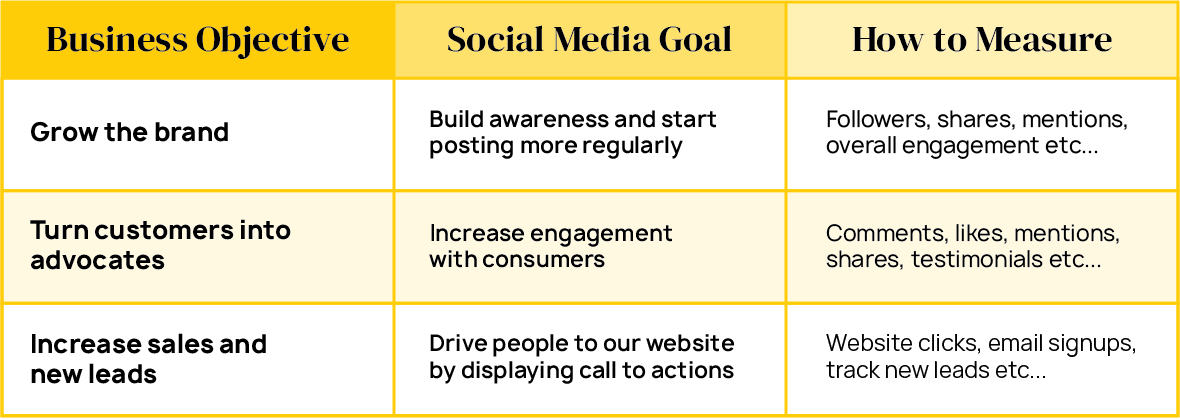
Identify your target audience
Just like the business persona, there is a helpful tool called a ‘buyer persona’ to help you figure out who your target audience is and how you can communicate with them. Try to be as specific as possible and create 2 or 3 so you get a range of people. By understanding who your audience are and how they walk and talk, you are able to choose channels and create content that will not only reach them, but also engage and intrigue them! Check out the example below.
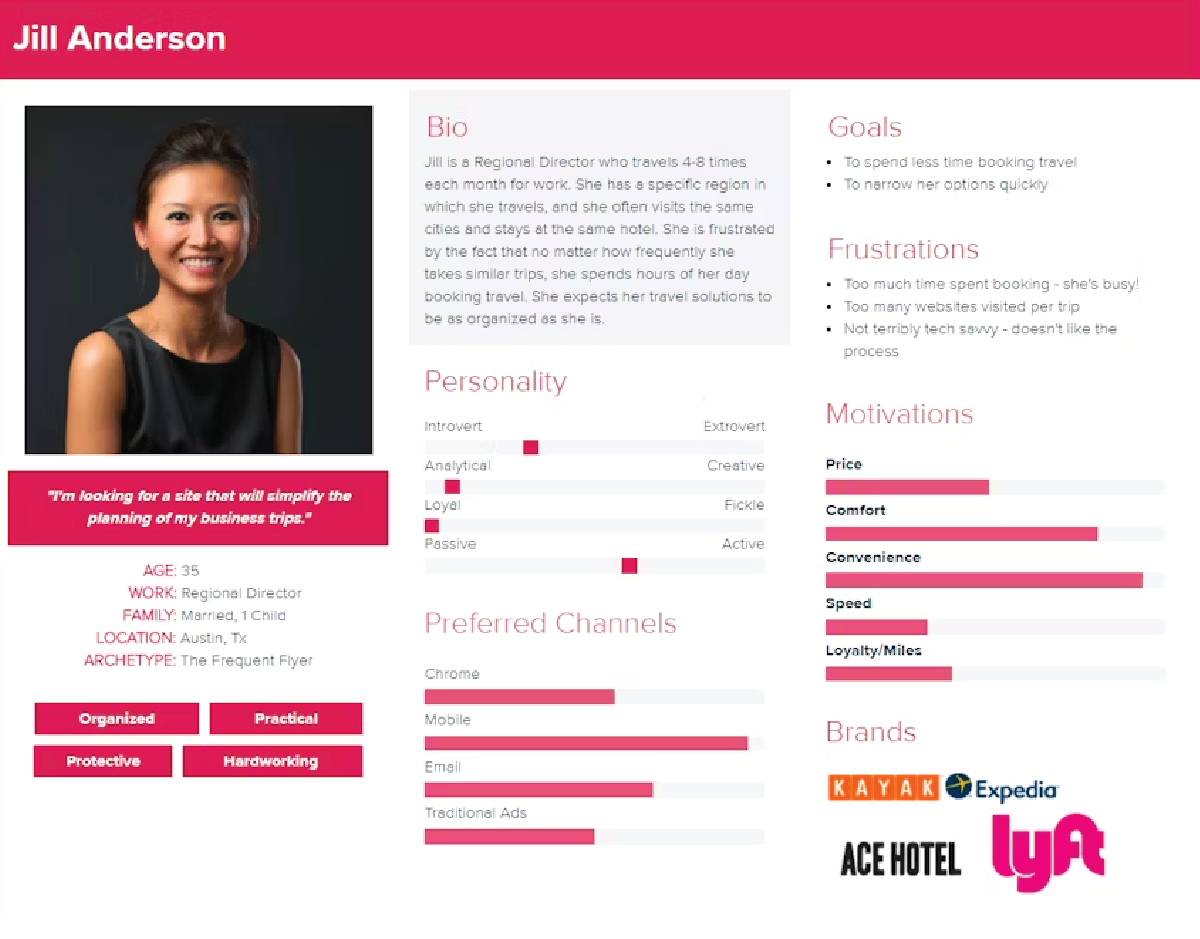
Source: https://99designs.com/blog/business/how-to-create-user-personas/
2. Choose your social media channels
One of the biggest mistakes you can make when setting up your business on social media is trying to be active on as many platforms as possible. I mean the more platforms you’re on, the more people you will reach, right? Wrong.
It is essential from the beginning that you are making decisions that will be efficient and effective. By taking the time to understand each platform, who they appeal to and the different features they have, you will be able to make more informed decisions about which ones will be right for you. Not every platform will be the most effective at reaching your ideal target audience so it’s better to put more energy into reaching the right people on the right platforms.
But how do you go about choosing the right ones?
Listen and observe
Start by setting up personal profiles on some of the most popular platforms and explore what they have to offer. There is no better way to learn than experiencing it yourself! Explore their features, understand the tone of voice used, and identify the types of content that’s posted. You can even go as far as searching popular keywords related to your business and understand how each platform interacts with those topics. Go wild and have fun! Getting excited about the platforms will make using them much easier!
Figure out where your target audience is
Use the research you did previously about defining your target audience to establish which platforms they will be using. Nothing matters if you aren’t using channels that are popular within your target audience, because you won’t be reaching the right people! Find out where the most engagement on each platform comes from and who their content is reaching.
Discover which channels your competitors use
The easiest way that you can figure out which platforms you should be using is by seeing which ones your competitors use. And no, it’s not cheating, it’s called being resourceful! You want to make sure that you are existing in the same spaces as your competitors so that people see you and choose you over them! This research will be a big indicator on the platforms you should be using. You can go on competitors’ websites and see which platforms are linked or search them on various platforms to see if they come up, and if they do, are they getting successful engagement on them?
3. Create your profiles
Now you know which platforms you should be using for your business, it’s time to create the profiles. This will look different on each platform, but most social media profiles require the same core pieces of information to get started. Here are some tips on how to create the most optimised profile and examples of ways that brands have successfully done this!
Choose your display name / handle
Every platform will require you to have a name to display on your profile so people know who you are and can find you easier. It’s a pretty good idea to use your business name as your username as this will cause the least amount of confusion! Platforms such as Facebook and LinkedIn are simple and will allow you to display your business name how it is.
However, platforms such as Twitter, Instagram and Tiktok will also require a ‘handle’, which is your unique profile address that helps make your account more discoverable on the platform. It is preceded by an “@” and doesn’t allow any spaces. It is important that your handle represents your brand, is easy to remember and is consistent across all social media platforms so that your business is recognisable and easy to find/tag.
Because handles are one of a kind, there is a chance that your name has already been taken by someone else, so you may have to do a bit more thinking. Here are some tips on how you could form your unique handle:
- Include keywords related to your business
- Shorten your business name
- Incorporate your brand personality
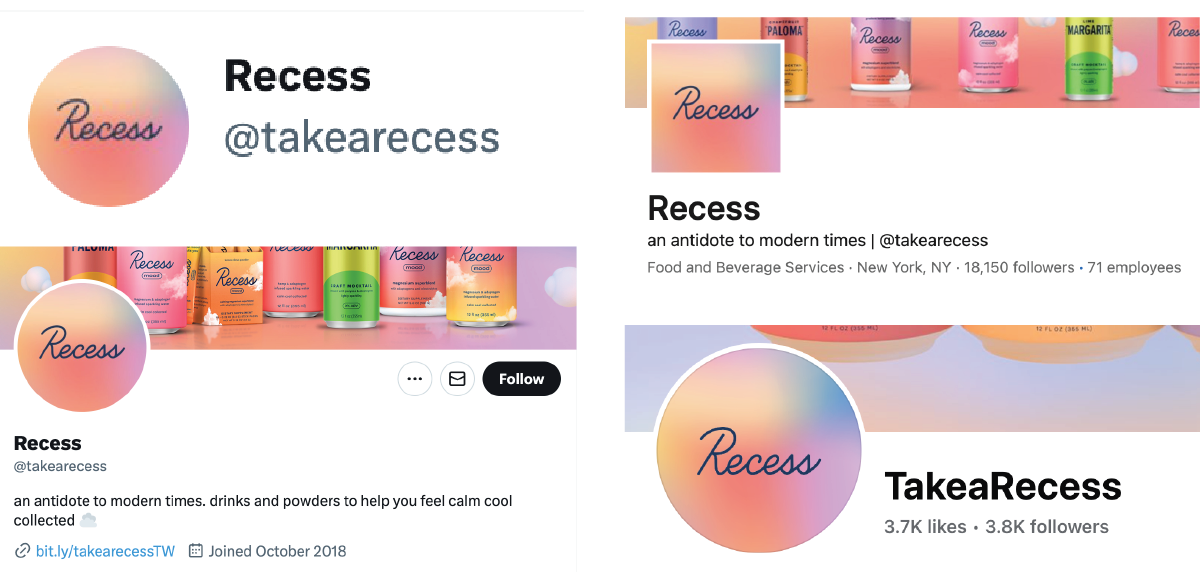
Recess are a great example of adapting your handle and username to the platform. Although their brand name is ‘Recess’, they use ‘@takearecces’ across platforms to differentiate themselves and inject their playful tone of voice.
Choose your profile photo
This is the first visual that people will see that will reflect your brand, so it’s important to make it a good one! If your profile image is poor quality, inconsistent across platforms, hard to see or just non-existent, you run the risk of losing the trust of people coming to visit your page for a lack of presence, responsibility and professionalism.
For a business, it’s important to consider how your profile image will be viewed before you throw your raw logo jpeg at it! Considering the following elements will help you to elevate your social presence and create intrigue with your potential consumers.
- How your logo will scale. Profile images can be viewed on a large scale when full size, but they can also be a teeny tiny preview in the corner of your phone screen. When creating a profile image, consider how it will look at both extremes. If your logo has detailed visual elements, you may want to consider a more simplified version for digital platforms.
- The image quality. Using high quality images for when your logo is scaled up is crucial. The quality of your visuals will directly reflect your reliability and … as a business, so make sure to check this before uploading!
- The readability of any text. Leading on from scale, you need to consider whether people will be able to read any text included on your logo. In most cases, you won’t need to include your business name in the logo because it will be included on your profile and… Of course, this only applies to logos where the business name isn’t integrated into the design.
- The background. Simplicity is key for your profile image, and the same applies to the background. Having a busy background can distract from your logo and all recognisability will be lost. Simple block colour backgrounds are effective and can create a high contrast with your logo, making it eye-catching and easy to see on a small scale. Colour can represent your brand as much as an image can, so choose wisely!
Simple, contrasting and recognisable profile images are always a hit when it comes to social media. Make sure that whatever you choose represents your business and can be easily identified to social media scrollers.

Bloom & Wild have simplified their logo into a brand mark to use as their profile image. It’s still recognisable as the brand and the contrast makes it easy to see both scaled down and up!
Choose your cover image (if necessary)
This is often a landscape image that sits above your profile image on your page. Not all platforms require a cover image, but some of the popular channels, such as Facebook and LinkedIn, do. You should be making the most of every opportunity you get to show who your brand is, especially if it’s visual. A striking cover photo that shows off your brand personality will contribute to how viewers will perceive your brand and help them decide if they want to keep scrolling.
It is also a piece of content that stays at the top of your page whilst your posts are ever changing. It’s a good way to display important news or information about your business without it getting lost in your feed. There are endless ways you can utilise this section of your profile, here are some of our cover image tips:
- Include your brand personality and tone of voice. Get playful with it! This is a great opportunity to show people what they can expect from your brand and invites them to take a look around your page.
- Say no to stock imagery. It’s impersonal, lazy and people can see right through it. Use imagery of your own products or services. People are much more likely to take interest in a business who is authentic and proactive.
- Use it for promotion. If you have any products, offers, or events coming up this is a great place to promote them as it’s the first thing they will see on your page. Make sure you only do this occasionally.
- Change it frequently. Once you get your head around setting up your profiles and posting, changing your cover image frequently is a good way to keep your profile current and reflects what’s going on in your business now! An outdated cover photo can make your profile look stale which reflects poorly on your business.
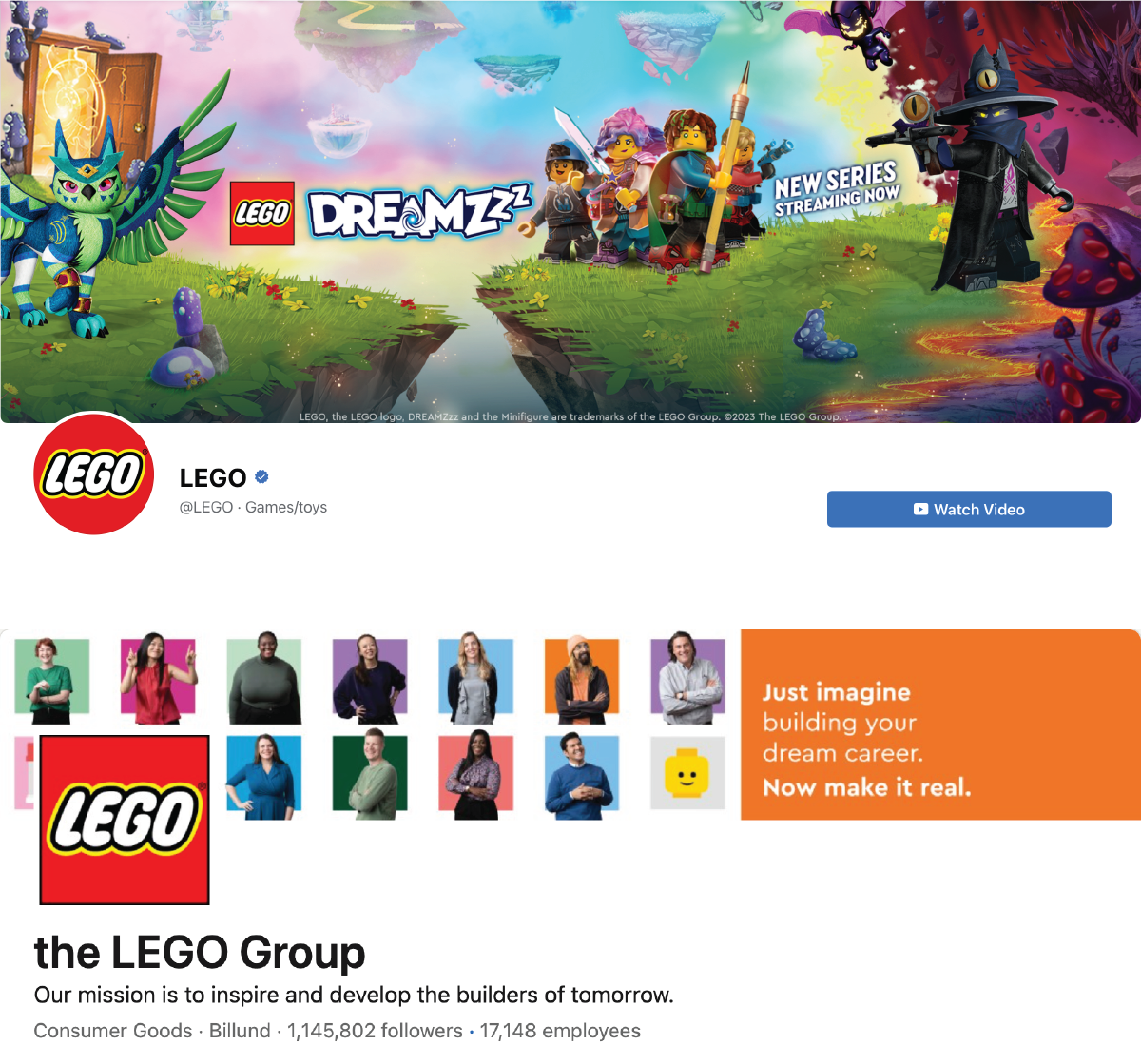
Lego are currently sporting a cover photo that advertises their brand new series on their Facebook, whereas over on their LinkedIn they have kept it simple and business focused to match the tone of voice of the platform. Very smart Lego!
Write your bio
This is the snippet of text that usually comes under your profile and cover image and should be a short but snappy summary of who the business is and what it does. It will help viewers determine whether to keep scrolling or click off, so it’s important to get it right.
This might seem tricky at first, but the payoff is worth it! A great bio can increase your searchability, drive more traffic to your website, grow your audience and increase customer trust. There are a lot of things you want to convey in your bio and, on platforms such as Twitter and Instagram, you don’t have many characters to do it. To make this easier for you, here are our top tips on writing the perfect social media bio:
- Include who you are and what you offer right at the start so that viewers know straight off the bat what they can expect from your business and this profile.
- Write it in your business’s tone of voice. This will help you maintain consistency across your platforms and help the viewer understand your brand personality.
- Include a call to action (CTA). Whether that’s to your website, an event you’re going to, a blog you use or a way to contact you, an obvious call to action directs the viewer to the next steps of finding out more about your business.
- Include keywords that relate to your industry and business to increase searchability.
Some bio spaces, such as Facebook’s, allow for more in depth information about your business. Make sure you utilise the space you have without overwhelming them with information. Concise and snappy information is easier to read and will maintain the viewers engagement for longer. Consider using bullet points and breaking the information up into smaller paragraphs for better readability.
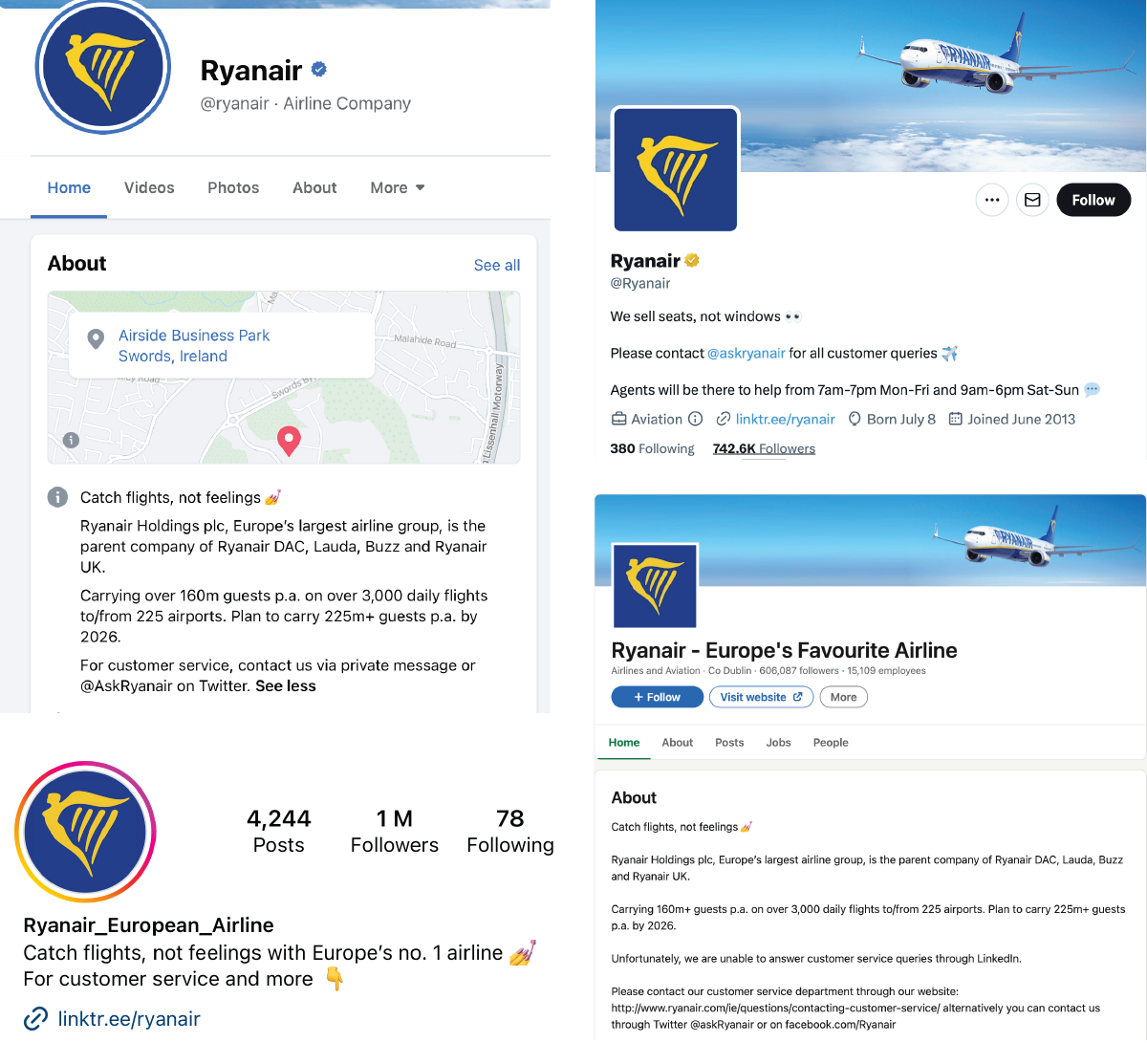
Ryanair has managed to channel their hilarious brand persona whilst also including important information about their business, on top of changing the format to match each channel. A round of applause for them!
Need some help setting up your business on social media?
What we discussed is only the tip of the social media iceberg, and we understand if it still feels like an alien concept! If you’d like help setting up or even running your business’s social media, you’ve come to the right place! Make sure to get in touch and we would be happy to give you guidance on how to ace your social media strategy or, to take this task off your hands completely! Find out more here.



